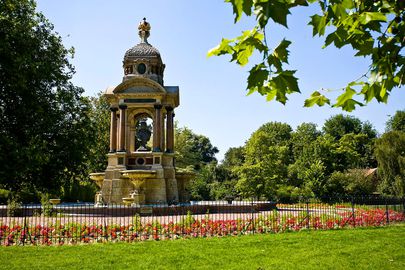

This relatively small park is named after the doctor and philanthropist Samuel Sarphati, who lived in the middle of 19th century and whose sumptuous monument dominates the park. The rectangular patch of green stretches for just two blocks, but it offers a vital breather in the heart of the densely populated and sometimes overcrowded De Pijp.
In the 1860s, Amsterdam’s chief architect van Niftrik had big urban development ambitions. He believed that the city centerwouldmove to the promising new neighborhood in the city's South West and, thus, intended the central train station (yet to be constructed then) to be placed exactly on the plot where the Sarphatipark is located today. This area was still rural then, dotted with windmills and divided into small country estates. However, when the grand urbanization plans failed, the same architect redrafted his plans and on the same spot envisioned a park in a free English landscape style. As a result of a petition signed by local residents, the park was named after doctor Sarphati.
Samuel Sarphati's ancestors were Sephardic Jews who arrived in the Netherlands from Portugal in the 17th century. Showing great promise, Sarphatiwas just 20 years old when he started studying medicine at Leiden University. Thereafter, during his work as a doctor in Amsterdam, Sarphati often came across poor hygiene among the underprivileged. This led him to initiate all sorts of public projects designed to improve the health and quality of life ofthe city’s residents. Examples included establishing a bread factory that produced wholesome and affordable bread, setting up a trash collection service andopening public bath houses.
Sarphati quickly gained popularity among the city’s inhabitants and became involved in politics. He had great vision in the city’s urban planning and droveimproved standards in education and industrialization. He also wanted to improve Amsterdam's international reputation by constructing impressive buildings such as the famous Amstel Hotel, where stars likethe Rolling Stones and Rihanna stay these days. Many of Sarpahti’s visions still have apositive effect on the city to this day. As well as the parka long thoroughfare in the city’s Eastern district is named after him.
During World War II the doctor’s non-Aryan origins sawthe bust of Sarphati removed from itspedestal in the park. The latter was renamed after the Dutch philosopher GerardusBolland, afollower of the German philosopher Hegel, whoseemed more appropriate to the Nazis. Twelve days after Amsterdamwas liberated on May 18, 1945 the original name and bust were restored to the park.
Unlike the streets around the neighborhood, the park wasn’t raised and mostly remains lower in the level than the rest of the neighborhood. The water that supplies the pond comes from the Singelgracht via an underground tunnel. The park was heavily criticized at first because of its stagnant water, which attracted swarms of insects.In response a pumping station was built on the western side of the park to regulate the water supply. This unique pumping station is considered a monument and is referred to as a ‘green pumping station’ becauseit has various nature activities such as for example, an ‘insect hotel’. Between 1908 and 1911, before taking off for Paris and then New York, the renowned Dutch abstract painter Piet Mondriaan worked at Sarphatipark number 42, which houses art studios to this day.